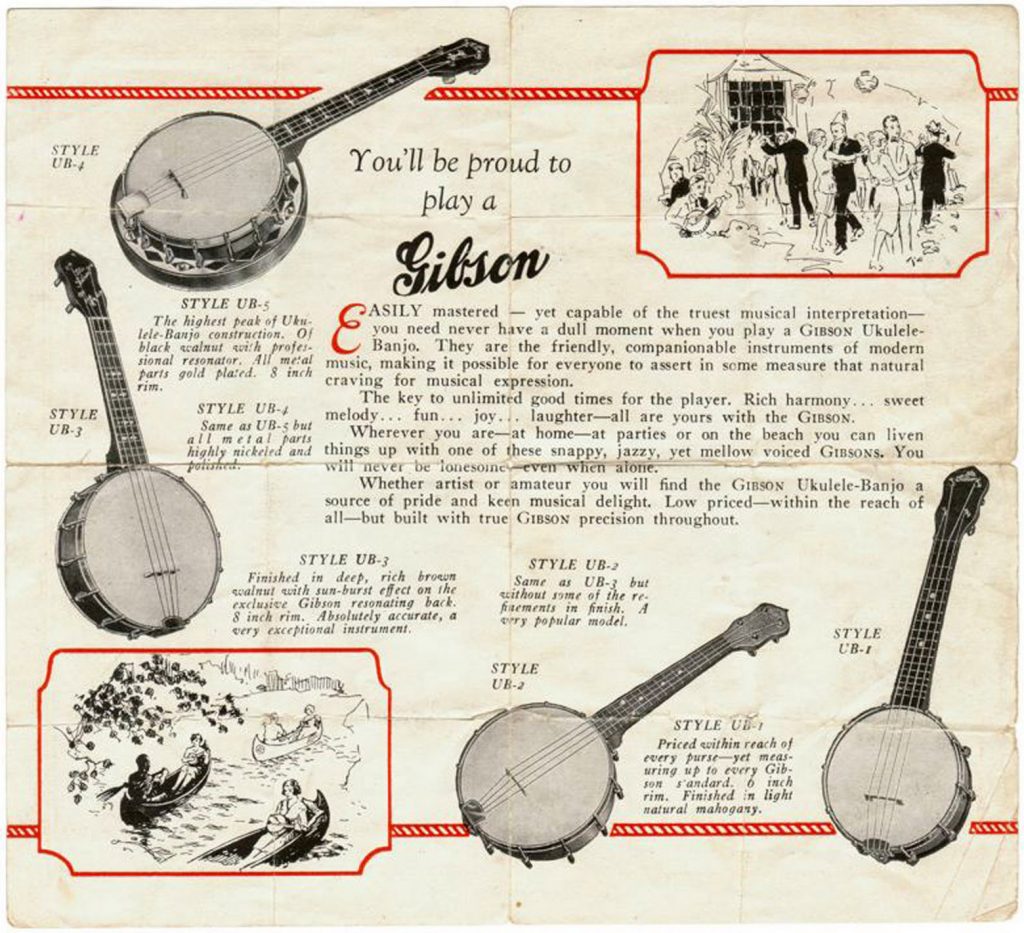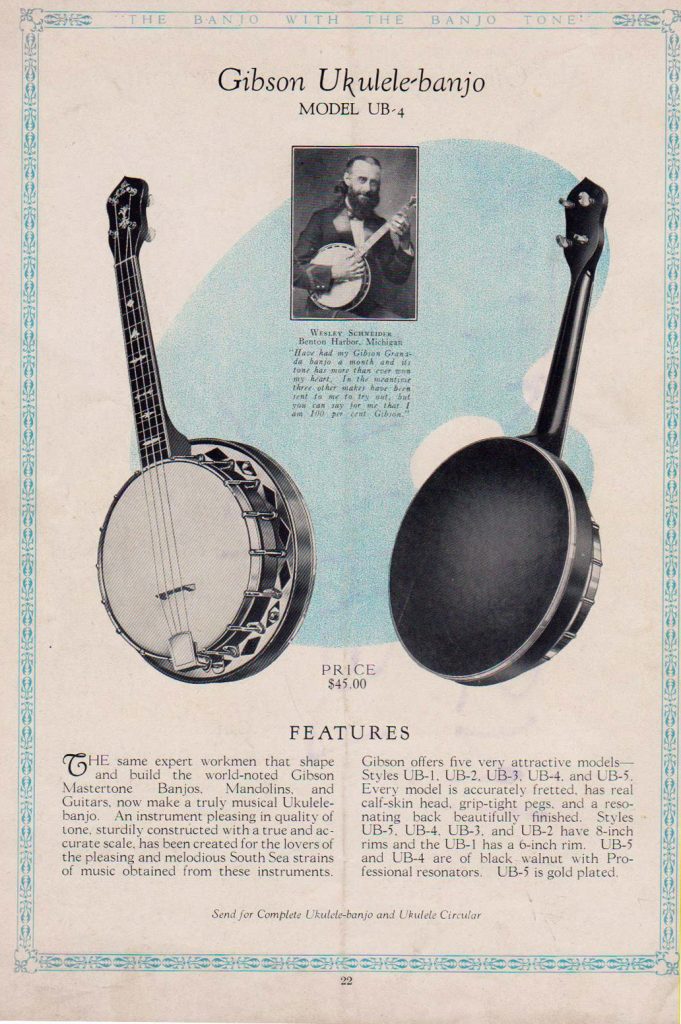Ukulele and banjo rolled in to one
I play a ukulele banjo (banjolele, banjulele, banjo ukulele or banjo uke) which is a fun instrument to play. It’s a four-stringed instrument with a banjo type body and a ukulele neck. The first ukulele banjos were built by John A. Bolander and by Alvin D. Keech, both in 1917. I have a vintage Keech Banjulele – a trademarked name, sometimes also spelled ‘banjolele’ or ‘banjelele’.
The ukulele banjo was in its heyday in the 1920s and 1930s, and it nicely combines the small scale, tuning, and playing style of a ukulele with the construction and distinctive tone of a banjo. It was development for vaudeville performers who needed an instrument that could be played with the ease of the ukulele, but with more volume since they had no amplifiers.
Ukulele banjo demo
Andy Eastwood demos a Gibson UB-3 and a Dallas Model E.
Gibson range of ukulele banjos
Style UB-1 – 6″ maple rim, resonator back.
Style UB-2 / UB-2 De Luxe / Baby Gibson – 8″ maple rim, resonator back.
Style UB-3 – 8″ maple rim, flange resonator.
Style UB-4 – 8″ walnut rim, burl walnut flange resonator nickle plated.
Style UB-5 – Gold plated version of the UB-4.
Dallas
Dallas sold five banjo ukulele models from A, B, C, D and E, with A being the basic to E as the top model. Dallas were endorsed by George Formby and bore his name and image on the headstocks. Final runs of the George Formby models were made by Musima in the DDR (East Germany).
Dallas B was a moderately priced professional instrument. Stained rosewood neck, body and box resonator. Ebony fingerboard perfectly fretted with special drawn wire and inlaid with pearl position marks. Non slip pegs. 6.75 inch flush rim, heavy bezel, 8 sunk pull down rods, metal tone plate. All parts nickel plated. White vellum. Complete in case, opening full length. Original price only £2.15.0. These are really nice banjo ukuleles to play and have a good build quality.
Musima
An interesting brand of ukulele banjos made in the DDR (East Germany) in the 60s and 70s. Musima made instruments using an available traditional skill base and were not suited to innovation. Their instruments tend to be well made but lack a certain esthetic and finesse. The ones I have seen are very well made and play well. I own a Musima ukulele banjo which I’ve been working on to improve it’s playing quality – new strings, service and set-up. UPDATE: The old thick varnish has been removed and now finished with Danish Oil – it looks and sounds great! A Remo Banjo Head would not fit so have currently stuck with the old one. A vellum replacement would be the only option.
John Grey & Sons
Quite a common brand of ukulele banjo and the ones I have seen are of a good quality. John Grey & Sons Ltd. was a subsidiary company of Barnett Samuel & Sons for the making and selling of banjos, guitars and drums. There seems to be a good range of sizes from 8″ to 10″ heads. I have one of each and look forward to seeing how loud the 10″ is!
Windsor
Originally a coffin furniture maker, Arthur Octavius Windsor started making Banjos in the 1890s and grew the company on the success of these stringed instruments. Credited for inventing the Zither Banjo and hidden drone string channel for 5 string banjos.
The Windsor factory closed in 1940 due to being destroyed by German bombing but during its heyday was the largest maker of fretted instruments in UK. Their Whirle was the most famous with its distinctive headstock badge used on both banjoleles and banjos.
Banjolele Tips & Info
Measuring your banjolele head diameter
Your banjolele rim may be slightly out of round, so take four diameter measurements at different points on the outside of the banjolele’s tone ring or rim top. Use the average diameter to the nearest 1/16″ to order the correct size.
Another dimension you may need to know is the crown height. It is the vertical distance from the top of the banjolele’s head mounting band to the top of the head.
Calfskin vellum banjolele drum head care
Vellum is a natural product made from calfskin, goatskin or other animal. It has several disadvantages compared to synthetic banjolele heads. Firstly, they are fiddly to fit. Secondly, they are susceptible to changes in temperature and humidity which can affect tuning. Lastly, they need more adjustment and can’t take as much tension.
My preference is a synthetic head since they are less troublesome, however you may not have a choice if your banjolele does not fit a standard size head or you head has become oval in shape.
Caring for your banjolele head is fairly straightforward…
Adjust your head for the weather conditions – on a warm, dry day your head will be tighter than on a cold, damp day. So bear in mind you will spend time adjusting the tension of you vellum head. A higher bridge can be used for non-adjustable vellum heads.
Avoid exposing your banjolele head to rapid changes in temperature or humidity. I keep mine in its case in a room which stays at a reasonably stable temperature.
Cleaning your banjolele head is not very easy. Best practice would be to use a slightly damp cloth gently dabbing at the dirty areas – bear in mind it won’t be perfect. Old time platyers would often use dubbin to keep the vellum in good shape but dubbin does attract dirt!
Your vellum head with a bit of gentle care and attention should bring you a nice vintage tone and look – you just need to be prepared to put the work in. If you’re like me and want to play with as less hassle than possible, then a synthetic Remo head may be a better choice.
Banjolele scale lengths
The scale length is measured from the nut to the bridge and are approximate.
Soprano: 13½”
Concert: 15½”
Tenor: 17″
Baritone: 19″
Typical banjolele string gauges and tensions
| Gauge | A | E | C | G | Tension |
|---|---|---|---|---|---|
| Soprano/Concert | .0191 | .0251 | .0340 | .0220 | 35.4 |
| Tenor | .0220 | .0284 | .0340 | .0251 | 55.3 |
| Baritone | .0220 | .0251 | .0340 | .0350 | 44 |


